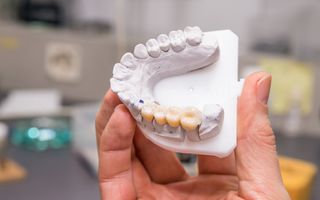
Do you have one or more missing teeth affecting your ability to eat, speak, or smile comfortably? Our friendly and experienced team at National Dental Care Barangaroo can help. We understand the importance of a healthy, complete smile, which is why we provide high-quality dental bridges to restore both the appearance and functionality of your teeth.
With years of combined experience, our knowledgeable team is here to assist; schedule an appointment with our team in Barangaroo today to regain dental function and enhance your oral health with a dental bridge.
What is a dental bridge?
A dental bridge fills the gap between two teeth using false teeth. Unlike a dental implant, it doesn’t need to be implanted into the jaw. Instead, the bridge connects a false tooth to the natural teeth on either side of the gap.
Dental bridges are a great alternative to dental implants, whether you simply don’t want one or your gums or jaw are not in good enough condition to receive an implant.

Dental bridges can be made up of metal, porcelain, zirconia, or a combination of any of the three. There are three types of dental bridges; Traditional, Cantilever, and Maryland bridges:
- A traditional bridge is the most common type of dental bridge. It involves placing dental crowns on the teeth that sit on either side of the gap and attaching a ‘pontic’ (a false tooth) between them.
- A cantilever bridge is less common. When there is only one tooth next to the gap, the dentist will place a crown over that tooth and attach the pontic to it. However, this method is less stable than attaching the pontic on both sides, which is why it’s not recommended for back teeth that bear a lot of pressure.
- The Maryland bridge style is named after the University of Maryland where it was invented. It’s similar to a traditional bridge, where a false tooth is attached to the teeth on each side of the gap. However, instead of using crowns, it uses 'wings' that attach to the back of each tooth next to the gap. It is important to note that this style is not recommended for back teeth and is only suitable for people with good oral health.
No matter the style, a dental bridge at National Dental Care Barangaroo will give you all the functionality of a full set of teeth, as well as a beautiful smile.
The advantages and disadvantages of dental bridges
The advantages of dental bridges:
- Non-Surgical Alternative: Dental bridges are an alternative to invasive dental implants, which involve anchoring the tooth to the bone beneath the gum line. This may not be suitable for everyone, especially those with underlying gum or jaw issues.
- A Complete Smile: Missing teeth can impact your confidence and make you feel self-conscious about your smile. A bridge fills the gap left by missing teeth with a natural-looking solution.
- Restored Functionality: A dental bridge offers full functionality, meaning you’ll be able to eat, drink, and talk normally.
- Improved Oral Health: A missing tooth can cause your other teeth to deteriorate faster, as well as leading to tooth movement. A dental bridge can prevent this, resulting in better dental health.
The disadvantages of dental bridges:
- Invasive for Adjacent Teeth: Traditional bridges occasionally require crowns to be placed on healthy adjacent teeth, which may involve reshaping and covering them. This can lead to the removal of some healthy enamel, potentially causing lasting harm to initially healthy teeth.
- Maryland Bridges Drawbacks: Maryland bridges, while less invasive, can damage existing teeth due to removal of enamel at the back of the teeth. They are also less resilient to chewing pressure compared to other bridge types.
- Ineffectiveness Against Bone Loss: When a tooth is missing or removed, the jaw bone that previously supported it can start to deteriorate. Unlike implants, which have an artificial root anchored into the jaw bone, bridges sit above the gum line and don’t have roots. As a result, bridges don’t prevent bone loss like implants do.
- Shorter Lifespan: Dental bridges are not expected to last as long as implants, which are designed for a lifetime. Over time, bridges may cause damage to the supporting teeth, potentially leading to the need for replacement.
it's important to think about these pros and cons when considering whether a dental bridge is the right choice for you. Your dentist at Barangaroo can help you make the right decision based on your individual circumstances.

What to expect from your dental bridge treatment
Before your appointment at National Dental Care Barangaroo, it's a good idea to eat something and drink water. This will help you avoid feeling hungry while you're there. Remember to brush and floss your teeth to keep them clean.
During the bridge procedure at our dental clinic, your dentist will:
- Make sure you're comfortable with local anaesthesia.
- Prepare your teeth for the bridge
- Take moulds or digital scans of your teeth to send to the lab.
- Insert a temporary bridge to protect your teeth until the custom bridge is ready.
Your follow-up appointment will be scheduled for about a week later, or when your custom bridge is finished. Here's what will happen at that appointment:
- Your dentist will numb the area again with local anaesthesia.
- They'll remove the temporary bridge.
- Your dentist will check that the permanent bridge fits correctly.
- If everything looks good, they'll attach the permanent bridge with dental cement.
- Your dentist will make sure the dental crowns and bridge fit comfortably with your bite.
After the procedure, you may feel numb in the area for a few hours. Your dentist will also examine the bridge during your follow-up appointment to make sure everything is okay. We want to make sure you have a comfortable experience at National Dental Care Barangaroo.

Ready to address the gap in your smile? At National Dental Care Barangaroo, we provide dental bridges to help restore both the appearance and function of your smile. Schedule a consultation with us today to take the initial step towards smile restoration.
Frequently asked questions
The cost of a dental bridge will vary depending on the type of bridge you get and the materials used, as well as some other factors.
At National Dental Care Barangaroo, your dentist will be able to give you a more accurate estimate once they have a better idea of your situation and oral health.
Keep in mind that your insurance may pay for some of the treatment, so it’s worth checking with your provider.
With proper care and regular check-ups at National Dental Care Barangaroo, a dental bridge can sometimes last for up to 10 years or longer
To ensure the longevity of your bridge, it is important to avoid biting down on hard or sticky foods that may damage or even dislodge the bridge. What’s more, maintaining good dental hygiene is crucial to keep your natural teeth and gums strong, which in turn support the bridge.
Absolutely! Unlike dentures, Dental bridges are permanently fixed to your existing teeth, and cannot be removed without damaging them.
